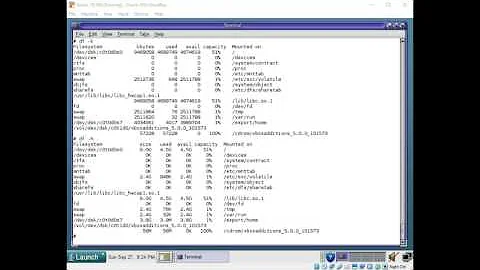Viewing the loopback interface on Solaris 10 (using snoop or another tool)
Solution 1
The posts are correct, you cannot snoop loopback traffic on solaris. You can't tcpdump it, you can't wireshark it. You can't dtrace it. Many have tried.
OpenSolaris supports it (via the clearview project).
Solution 2
I realize that this is an old thread, but in case someone stumbles across it, it is worth noting that this appears to now be possible in Solaris 11:
http://docs.oracle.com/cd/E23824_01/html/821-1453/gexkw.html#gexnc
There is now a '-I' option that allows snoop to work with IP-layer devices.
Solution 3
I vaguely recall some problems with snoop on the loopback interface (something about snoop requiring a real piece of harware which is why you get that DLPI message -- there's no Data Link Provider Interface for loopback b/c it's a virtual device).
You may want to try Wireshark or plain-ol-tcpdump, but you might be out of luck Re: lo0. As an alternative you could connect one of your physical interfaces to a dead-end hub with nothing else & send your traffic over that interface.
Related videos on Youtube
Daniel Attfield
Updated on September 17, 2022Comments
-
 Daniel Attfield almost 2 years
Daniel Attfield almost 2 yearsI'm coming to the beta deployment phase of building a Node.js application running through iisnode on Windows Azure. Having set up multiple instances, as well as production/staging separation, my research has led me to the following conclusion:
If I want to change configuration settings on the fly without redeploying code, I need to use Service Configuration
.cscfgfiles.My problem is that I've stored various configuration settings in the
<appSettings>and<iisnode>elements ofweb.configthat I might want to change, which are currently exposed in my Node application via the process global object.I've looked around MSDN, Node documentation and SO (the usual), and can't find if Node does or can expose Service Configuration settings in the same way. If not, is there a way I can expose them to my application?
Edit: To be more specific, I'm really only looking to move the
node_envsetting fromweb.configto Service Configuration, since I'd like to be able to switch from staging to production setup with just a config change. The reason - we're using IP switching to swap between staging and prod, and there are some very minor differences between the two (the URL of the RESTful web service it consumes, for example).I also know I can configure
node_envin aniisnode.yamlfile read by iisnode, but that will still recycle the application, and I don't want to modify x yaml files and redeploy, where x is the number of instances of the production/staging application. -
codebyren over 14 yearstcpdump fails with a similar error message. "tcpdump: lo0: No such device exists" "(lo0: No DLPI device found)"
-
Hubert Kario over 12 yearsIt's OK to add information to old questions, especially when it solves the problem.
-
 Daniel Attfield almost 12 yearsI could easily be wrong, but I wouldn't agree that you're not supposed to access these - the API that comes with the Azure Cloud tools contains the Microsoft.WindowsAzure.ServiceRuntime assembly and namespace. Within that, the RoleEnvironment class provides a static method for accessing these configuration values at runtime. Great for C# and what have you, but not for Node.
Daniel Attfield almost 12 yearsI could easily be wrong, but I wouldn't agree that you're not supposed to access these - the API that comes with the Azure Cloud tools contains the Microsoft.WindowsAzure.ServiceRuntime assembly and namespace. Within that, the RoleEnvironment class provides a static method for accessing these configuration values at runtime. Great for C# and what have you, but not for Node. -
user94559 almost 12 yearsI think he's saying you're not meant to read the XML file on the VM. (You're supposed to use the API.)




